Interesting story mechanic told me...
Announcements
-
Similar Content
-
Latest Posts
-
We have some more genuine Japanese legally decommissioned car number plates in stock 🙂, as well as the plain white 40mm hole cover: Tama 400 No 12-41: https://www.oemsoko.co.jp/products/genuine-decommissioned-japanese-vehicle-number-plate-set-no-1241 Morioka 300 Te 43-58: https://www.oemsoko.co.jp/products/genuine-decommissioned-japanese-vehicle-number-plate-set-te-4358 Plain White 40mm Hole Cover: https://www.oemsoko.co.jp/products/genuine-japanese-vehicle-number-plate-40mm-hole-cover-white There's also a yellow plate for Kei cars with the corresponding yellow 40mm hole cover sold as a set: Tsukuba 581 Ii 64-66: https://www.oemsoko.co.jp/products/genuine-decommissioned-japanese-vehicle-single-number-plate-ii-6466 Also some Skyline 1/43 scale models: 1989 BNR32 Nissan Skyline GT-R (Silver): https://www.oemsoko.co.jp/products/rare-ebbro-oldies-2006-release-bnr32-nissan-skyline-gtr-silver 1989 HCR32 Nissan Skyline GTS-t Type M (Red): https://www.oemsoko.co.jp/products/kyosho-original-1-43-hcr32-nissan-skyline-gts-t-type-m-red
-
These arrived today! Sadly I'm going to probably be smart and enjoy the car as is over the summer/sunny period and save the ~2 weeks downtime it'd take to swap the heads over and tune later in the year. Maybe. It's going to be pretty damn tempting seeing these bolt on funs just sitting in storage when they're ready to go. There's a non-zero chance I end up @The Bogan'ing it.
-
I was driving behind an FG (or something similar) Falcon ute with a shopping trolley wing (1/3 the height of that ^ one) on the back end of the hard cover....and it took me 5s to realise I wasn't looking at an NSX. f**king bogans.
-





Recommended Posts
Create an account or sign in to comment
You need to be a member in order to leave a comment
Create an account
Sign up for a new account in our community. It's easy!
Register a new accountSign in
Already have an account? Sign in here.
Sign In Now